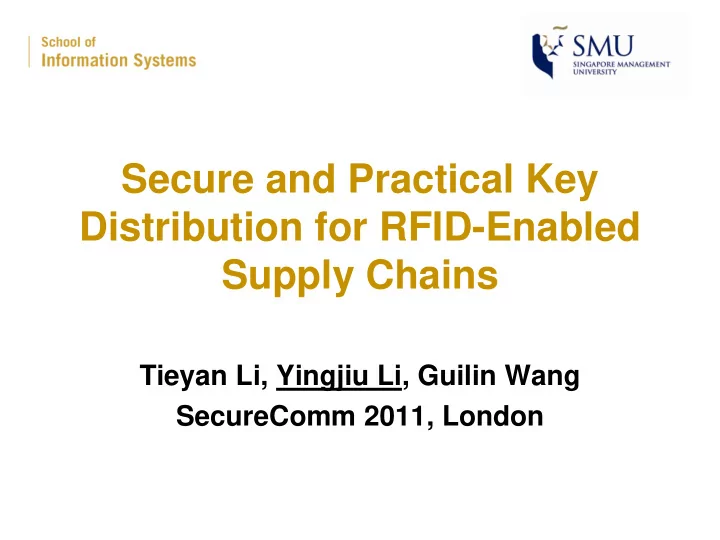

Secure and Practical Key Distribution for RFID-Enabled Supply Chains Tieyan Li, Yingjiu Li, Guilin Wang SecureComm 2011, London
Outline • Motivations • Related Works • Contributions • Scenario • Desired Security Properties • Resilient Secret Sharing (RSS) • Our Construction • Parameterization • Conclusion 2
Motivations • RFID-enabled supply chains – RFID tags, readers, and supply chains – RFID security and privacy issues – Symmetric key based solutions – Key distribution problem – Lack of pre-existing trusted relationships in large-scale dynamic supply chains 3
Related Works • Centralized control (OSK’04,MW’04,LD’07) – A centralized DB manages all tag keys – Not practical for large-scale dynamic supply chains • Secret sharing on tags (LM’07,JPP’08) – The encryption key for a batch of tags are shared among the tags – Not secure due to weak adv model and clone attack 4
Contributions • Secure and practical key distribution for RFID-enabled supply chain – Practical: focalized viewpoint on any pair of consecutive parties linked by a transaction and a 3 rd party who delivers goods (auth tags with errors) from one party to the other – Secure: strong adv model (no clone/privacy attack even for the 3 rd party) 5
Scenario • Batch goods delivery from A to B by C – Each item is attached with an RFID tag – C can authenticate the tags (with certain errors) but cannot know tag IDs or clone tags 6
Desired Security Properties • Authenticity of tags by C – Case based, or individual tag authentication – Tolerate certain reading errors or tag missing – No access to tag content or clone of tags • Authenticity/accessibility of tags by B – Authenticate tags in batch (with robustness) – Obtain all secret information to access/update individual tags • Privacy protection against C/adversary – Tag IDs encrypted by A can be accessed/ decrypted by B only (not C or any adversary) 7
Resilient Secret Sharing (RSS) • McEliece’s RSS based on Reed-Solomon codes (CACM’81) – Let B=(b1,b2,… bk) be the secret, where bi in BF(2^m) – There exists D=(d1,d2,… dn) in (k,n)-RS code, where di=bi for i<k+1. – The last n-k symbols in D are available for distribution to those sharing the secret. – At least k shares are required to recover the secret 8
RSS at High Level • • Recover secret by combining shares from both physical flow and information flow • Any single flow cannot contribute enough shares (r<k and n-k-r<k) • Allow more shares contributed from information flow to compensate the missing shares in physical flow • A minimum number of shares should be contributed from information flow so that an adversary’s guessing attack on missing shares is difficult 9
Our Construction • R tags in a batch, allocated equally in l cases, with r tags per case (R=l*r) 10
Our Construction • EPC C1G2 tags – EPC Memory 48 bits pseudo-ID (PID) • 1 share (16 bits) for x • 1 share (16 bits) for y • 1 sequence order (16 bits) • Adversary can access PID, which changes for different peers – User Memory encryption of 96-bit EPC code • Encryption key e=H(y) • Accessed and decrypted by B only (ID secrecy, anti-clone) – Reserved Memory 32-bit APIN and 32-bit KPIN • APIN = H(x,PID)[15:0] || H(y,PID)[15:0] • KPIN = H(x,PID)[31,16] || H(y,PID)[31:16] • C can obtain half APIN and KPIN for authentication • B can obtain whole APIN and KPIN for auth//acc/ident/upd 11
Comparison of Security Properties • [9]: OSK’04 • [8]: MW’04 • [6]: LD’07 • [4]: JPP’08 12
Parameterization • Philips UCODE Gen2 tag (512 bits) – EPC (96 bits), TID (32 bits), User (128 bits), Reserved (64 bits for access and kill PINs) • Running Example – 100 tags/batch 5 cases with 20 tags/case – Case level authentication with secret x • (28,60)-RSS: 32 shares with 16 bits/share • 448-bit secret x • 20 shares for tags/case and 12 shares to C • C tolerates up to 4 or 20% reading errors on scanning the case – Batch level access with secret y • (108,236)-RSS: 108 shares with 16 bits/share • 1728-bit secret y • 100 shares to tags/batch and 28 shares to B • B tolerates up to 20 or 20% errors on scanning the batch 13
Conclusion • Practical and secure key distribution for RFID- enabled supply chains – Peer-to-peer transaction with 3PL – 3PL can authenticate tags (in cases) with resilience to certain reading errors – No adversary or 3PL can access/clone tag content – Receiving party can authenticate/access/update tags (in batches) with resilience to certain reading errors – Our solution can be easily incorporated in standard RFID appliances 14
15
Recommend
More recommend